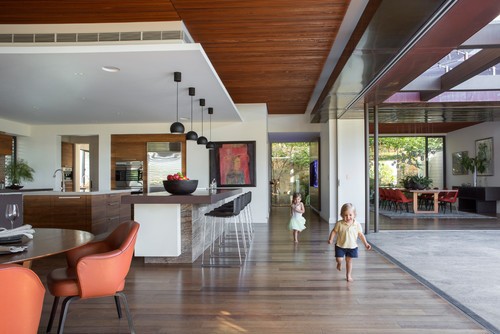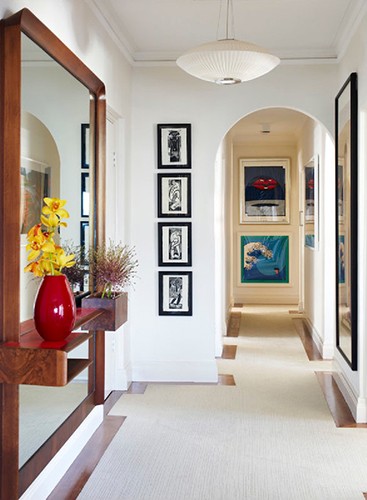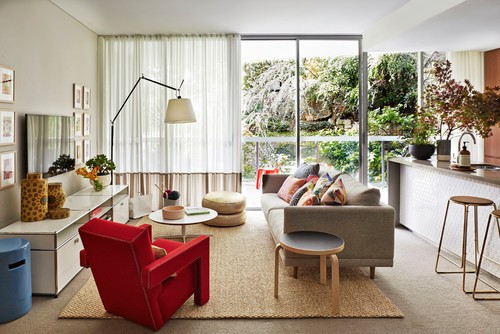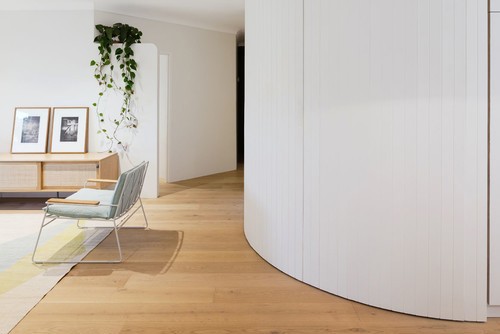Focus on where your eye is drawn, not just where you will spend all your time.
When you’re sitting or walking through your home there are views you do want to see, and spaces you don’t. The garden, for example, is a view you want; the powder room is a view you don’t. That’s why sightlines matter. A sightline is a hypothetical line from your eye to what can be seen in front of you. And when it comes to the design of a house, there are good and bad sightlines. Essentially, good sightlines bring pleasant and advantageous views into focus while concealing private spaces as much as possible. So here’s what you need to know about sightlines.
Benefits of Sightlines
They make a home feel open and airy
Views from one space to another can enhance the sense of openness and flow. By creating interior views from one space through another and then to the outdoors, a house can feel larger than it actually is. And as the windows or glass doors at the end of a sightline let in natural light, your eye is drawn towards them.

Photo by Neil Cownie Architect Pty Ltd – Search contemporary kitchen pictures
They allow you to keep an eye on the kids and guests
An open-plan space naturally lends itself to more open sightlines. But even in smaller homes or more enclosed spaces, sightlines from one room to another can help you keep an eye on kids or to more easily socialise with family, friends and guests.
The openness of the kitchen, dining and outside area means there is an open sightline throughout. The kids can play in sight of mum and dad, or guests can socialise while in view of the hosts.
They enable better communication through the home
Lines of sight could also be regarded as lines of communication. Having a clear view through various spaces, such as the kitchen, dining and living area, allows residents to be in different but related parts of a house while still being able to see and easily communicate with one another.

Photo by Niche Design & Build – Look for bedroom decorating ideas
Limiting lines of sight increases privacy of bedrooms and bathrooms
There are some instances when you don’t want an open sightline, for example from the hallway through the master bedroom and into the master bathroom. Configuring spaces to limit this line of sight increases privacy and comfort and improves the ability to be carefree.
Sightlines to Consider
Through the hallway
Hallways create a natural sight line because they guide your eye from one space to another. A hallway with a window or door at the end is an appealing sightline – a glass window or door draws the eye towards natural light, and a solid door promotes a sense of symmetry.

Photo by Scott Weston Architecture Design PL – Search contemporary entryway design ideas
If there is a wall at the end of the sightline, consider how you arrange furniture, decorative objects or artworks in order to create visual interest and draw the eye through the space.
Taking measures to interrupt sightlines like these is worth doing in the planning stages – they’re harder to undo once a home has been designed and built.

Photo by Arent & Pyke – Look for curtains and blinds
From the kitchen to the television
By having a sightline from the kitchen to the television, those in the kitchen preparing, cooking, or cleaning can still catch up on the news or stay tuned in to entertainment. Or if family or friends are watching television, then those in the kitchen can still be part of the action.

Photo by Retallack Thompson – Browse wall colours for your home
To conceal bedrooms and bathrooms
Sightlines are also about what you can’t see, and generally bedrooms and bathrooms shouldn’t be visible from public areas, if possible.
It can be hard to conceal private spaces or to improve sightlines in a small house or apartment, but it can be achieved with smart solutions. This apartment has a three-quarter wall that extends in front of the master bedroom so that its entrance can’t be seen from the living room.
Obstruct neighbours’ view
Since you don’t need neighbours having prime viewing into your bedroom or bathroom, their sightlines should be obstructed as much as possible. This can be done by strategically positioning windows either higher up the wall or asymmetrically so that walls or doors block their view.

Photo by Angus Mackenzie Architect – Browse transitional kitchen photos
Vertical sightlines
Sightlines are not only horizontal, but vertical. Being able to see the tops of trees, mountains or the city skyline can enhance the view from a house and its connection the outside world. Clerestory windows are one way to increase vertical sightlines, as well as to allow more natural light to filter into a space.
Final Tips
When planning a house layout, take time to consider sightlines. Lay a straight edge or draw a straight line through rooms to see what is visible from certain points in the house. And don’t forget the mirrors (especially in bathrooms and powder rooms); ensure the reflected view also contributes to an advantageous and pleasant sightline.





